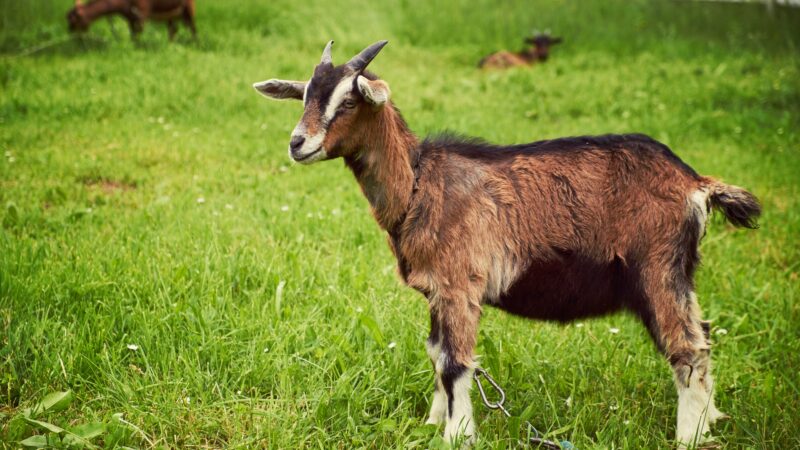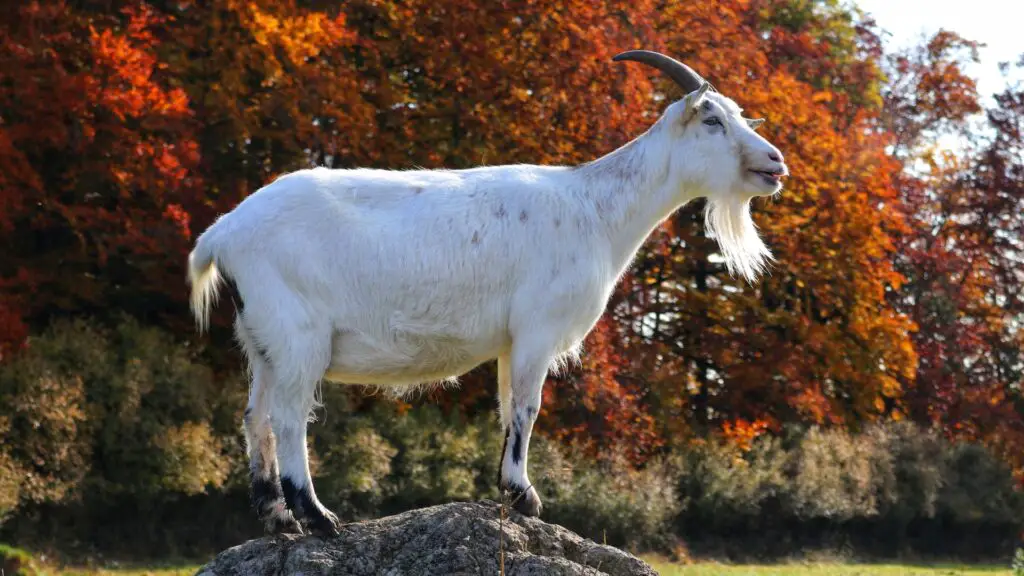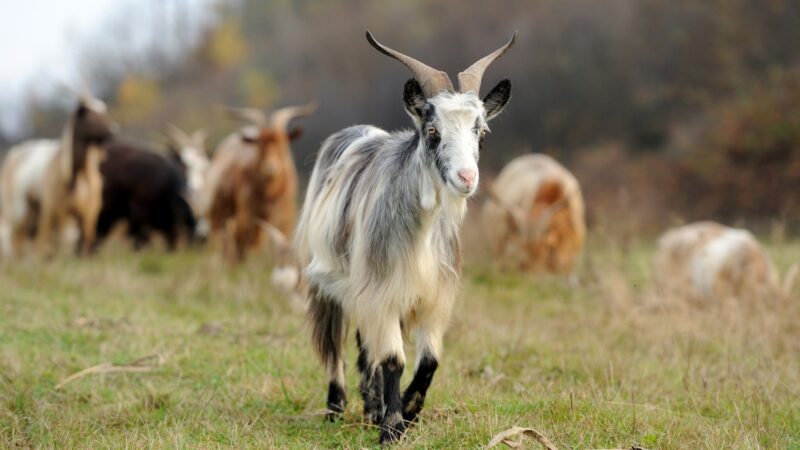Goats have evolved to have unique and fascinating eyes that have helped them survive in the wild. The rectangular shape of their pupils, a distinct adaptation, provides them with a wider field of view. This feature makes it easier to detect predators from different angles. Additionally, their eyes have a large number of rods, which makes them ideal for night vision.
Apart from their unusual pupils and excellent night vision, goats also have a nictitating membrane, which serves as a protective layer to shield their eyes from dust and debris. Goats rely heavily on their vision to navigate their surroundings, and their eyes have adapted to help them see in low-light conditions.
Having a comprehensive understanding of goat vision is vital for both animal lovers and goat owners. By exploring the intricacies of goat eyesight, we can gain a deeper appreciation for these remarkable creatures and the challenges they face in their daily lives.
Why Do Goats Have Weird Eyes?

The rectangular shape of goat eyes may seem unusual to us, but it is a vital adaptation for these prey animals. Unlike round pupils, which restrict the amount of light entering the eye, rectangular pupils provide goats with a broader field of view. This allows them to spot predators coming from various directions.
Moreover, their nictitating membrane serves as a protective layer that shields their eyes from dust and debris in dry environments. These features have developed over time to help goats thrive in the wild.
Do All Goats Have Horizontal Pupils?
Although horizontal or rectangular pupils are common in many goat breeds, not all goats share this distinct eye shape. The shape of a goat’s pupil is mainly influenced by its environment and predator-prey relationships. For instance, diurnal species like humans have circular pupils that enable them to focus on a particular point.
On the other hand, prey animals, such as goats, require a wider field of view to be vigilant against threats from all angles. Hence, their pupils are wider at the center and narrower at the edges. Therefore, while horizontal pupils are widespread in goats, they are not present in all goat breeds.
Are Goats the Only Animals With Rectangular Pupils?
Rectangular pupils are not only unique to goats. Other animals, such as sheep, horses, and certain species of octopus, also have this eye shape. This adaptation allows for a wider field of view, which is critical for detecting predators approaching from various angles.
It is interesting to note that the shape and size of an animal’s pupils can change based on their surroundings and level of arousal. For instance, when threatened or aroused, cats’ and some reptiles’ pupils can become vertical slits. This can enable them to focus their vision on a specific point.
This adaptive feature highlights the remarkable ability of animals to respond quickly to changes in their environment and adapt accordingly.
Why Are Goats’ Eyes Slanted?

The apparent slanted appearance of goat eyes is caused by the position of their rectangular pupils. Due to the horizontal orientation of their pupils, the eyes can create an optical illusion that makes them look slanted.
However, this does not impact the functionality of their eyes. In fact, the rectangular shape of their pupils enables goats to have a wider field of view. It can also detect predators more effectively, which is vital for their survival.
Do Goats Have Good Eyesight?
Goats possess exceptional eyesight, especially when it comes to detecting movement and seeing in low-light conditions. Their eyes contain a greater number of rod cells than humans, enabling them to see better in dim light.
Additionally, goats have a broader color spectrum, including the ability to see ultraviolet light. Their rectangular pupils grant them a wider field of vision and depth perception, making them highly adept at detecting predators and navigating their environment.
How Far Can a Goat See?

The precise distance that goats can see varies based on several factors, such as lighting conditions, terrain, and the size of the object being viewed. Nevertheless, their exceptional eyesight enables them to detect motion from a considerable distance and see well in low-light conditions, giving them an edge in navigating their surroundings at night.
Thanks to their rectangular pupils, goats can even perceive objects behind or beside them without needing to turn their heads. This feature enhances their situational awareness and allows them to respond quickly to potential threats.
What Do Goats’ Eyes See?
Like all creatures, goats perceive a range of colors and shapes in their surroundings. Nonetheless, due to the location and shape of their pupils, goats enjoy a more comprehensive field of vision and better depth perception than humans. This helps them detect predators from various angles and avoid obstacles while on the move.
Furthermore, goats possess exceptional low-light vision, which is essential for their survival in the wild. They can see objects at a distance and discern motion from a great distance. In general, goats’ eyesight has evolved to equip them with the necessary tools to navigate their environment and evade threats.
Can Goats See in the Dark?
Indeed, goats can see in the dark. Thanks to the high number of rod cells in their eyes, goats possess excellent night vision.
Rod cells are photoreceptor cells that detect light and dark, and they are more sensitive to light than the cone cells responsible for color vision. This means that goats can see well in low-light conditions, providing them an edge in detecting predators or foraging for food at night.
However, like all animals, goats still require some level of ambient light to see. In complete darkness, their vision would be impaired.
Can Goats See Colors?

Goats can see colors, but their color vision differs from that of humans. While humans have three types of cone cells in their eyes that enable us to see a broad range of colors, goats only have two types of cone cells.
Consequently, goats cannot differentiate between all colors in the same manner as humans can. Nevertheless, goats are still capable of seeing several colors, such as blues and yellows.
Moreover, goats can see ultraviolet light, which is invisible to humans. All things considered, while goats’ color vision may differ from ours, it remains a valuable tool that they use to navigate their surroundings and interact with other goats.
What Colors Do Goats See?
Although goats are capable of perceiving a range of colors, their color vision differs from that of humans. While humans possess three types of cone cells in our eyes, which enable us to see a vast array of colors, goats only possess two types of cone cells.
Consequently, they are unable to differentiate between all colors in the same way that humans can. Nevertheless, goats are still capable of seeing blues and yellows, which are crucial colors in their environment.
Additionally, goats can perceive ultraviolet light, which is invisible to humans. In general, while goats’ color vision may be more limited than humans, it remains an important tool that they use to navigate their environment and communicate with other goats.
Do Goats Need Light at Night?
Despite their excellent night vision, goats still require some degree of ambient light to see. In complete darkness, their vision would be hindered. Providing some level of light at night can also prevent injuries or accidents, especially if goats are housed in an unfamiliar environment.
However, bright lights at night are unnecessary, and excessive light can disturb their natural sleep patterns. It is vital to strike a balance between providing enough light for goats to see and ensuring that they have a dark, quiet environment to rest in.
Ultimately, the amount of light needed by goats at night will vary depending on the individual animal and its specific needs.
Related Questions
Can Goat’s Eyes Replace Humans?
Despite having excellent eyesight, goats’ eyes cannot replace human eyes. Although they may perceive things differently or have advantages in specific situations, they lack the same level of complexity and resolution as human eyes.
Moreover, goats’ eyes are tailored to the particular requirements of these animals and may not be able to offer the same level of information or detail that humans need.
Therefore, goats’ eyes cannot substitute human eyes in any way. Nonetheless, investigating the distinctive traits of goat eyes can provide valuable insights into the development and adaptation of vision in different species.
What Shape Are Goats’ Eyes?
Goat’s eyes have rectangular or horizontal pupils, imparting a distinctive slanted appearance. The rectangular shape of their pupils provides them with a broader field of view, enabling them to spot predators from various angles.
Moreover, goats’ eyes feature a protective membrane known as a nictitating membrane, shielding them from dust and debris. Although their eyes may appear distinct from those of other animals, the unique shape and characteristics of goat eyes have developed over time to ensure these animals’ survival in the wild.
All in all, goats’ eyes are exquisitely adapted to the specific needs of these intriguing creatures.
Can You Eat Goat Eyes?
Although it is technically feasible to consume goat eyes, it is not a typical practice in most cultures. While some cultures consider eating the eyes of certain animals as a delicacy, this is not a common practice for goats in most parts of the world. As a rule, goat meat is a popular food in numerous regions worldwide, but most individuals do not consume the eyes or other organs of the animal.
Are Goats Smart?
Indeed, goats are highly intelligent animals with excellent memories and problem-solving abilities. As social animals, they are capable of recognizing individual members of their herd and communicating with one another using various vocalizations and body language.
Goats are also renowned for their curiosity and adaptability, quickly learning from their surroundings. Furthermore, they have demonstrated a variety of emotions and can experience feelings such as stress, anxiety, and happiness.
In general, goats are captivating creatures with distinct personalities and intellects, constituting an essential component of many ecosystems and cultures worldwide.
Why Do Goats Like to Be up High?
Goats have an innate desire to be elevated since it is a natural behavior that assists them in escaping predators and locating food. In the wild, goats frequently reside in mountainous areas where they must climb to access food and remain secure from predators.
This conduct is also observed in domesticated goats, who frequently ascend structures or other items to explore their environment. Furthermore, being elevated enables goats to have a superior view of their surroundings and observe potential hazards.
Related: Why Goats Love to Jump | How High Can They Go?
Why Do Goats Faint?
Goats can experience fainting or “fainting” as a result of a genetic disorder known as myotonia congenita. This condition causes their muscles to stiffen when they become startled or excited, resulting in them collapsing and appearing to faint.
Although it may seem concerning, fainting goats are not in any discomfort or anguish, and they quickly recover and return to their usual activities. Fainting goats were once selectively bred for their unusual characteristic since it made them easier to handle on farms. However, this practice has largely fallen out of favor, and the majority of goats today do not have this condition.
